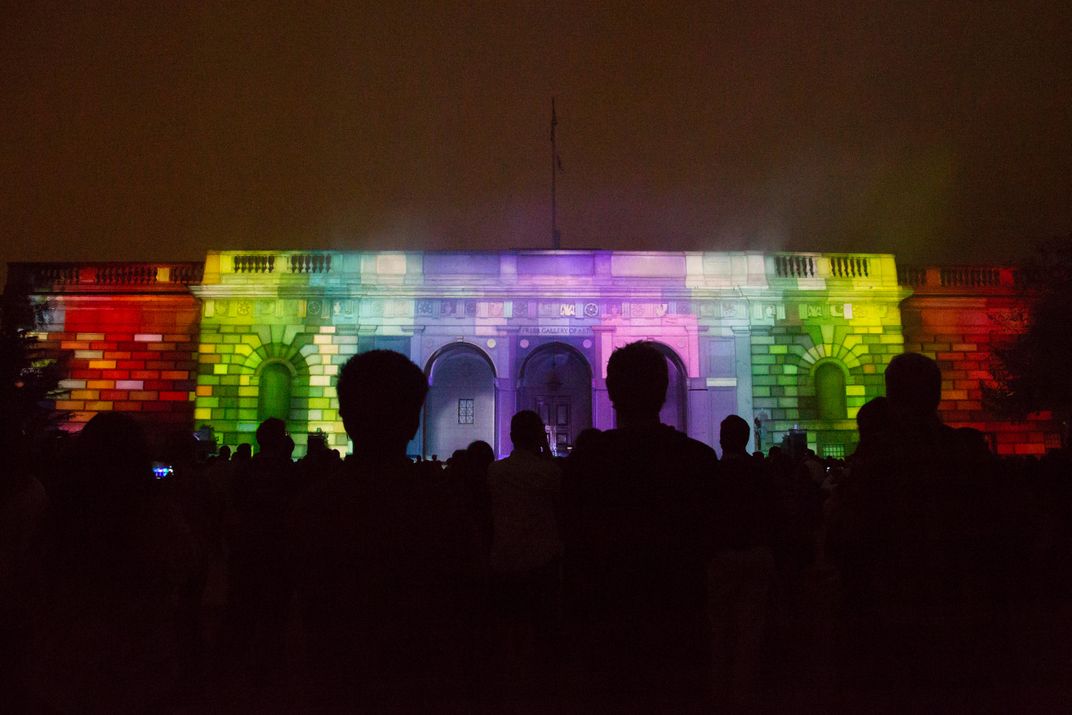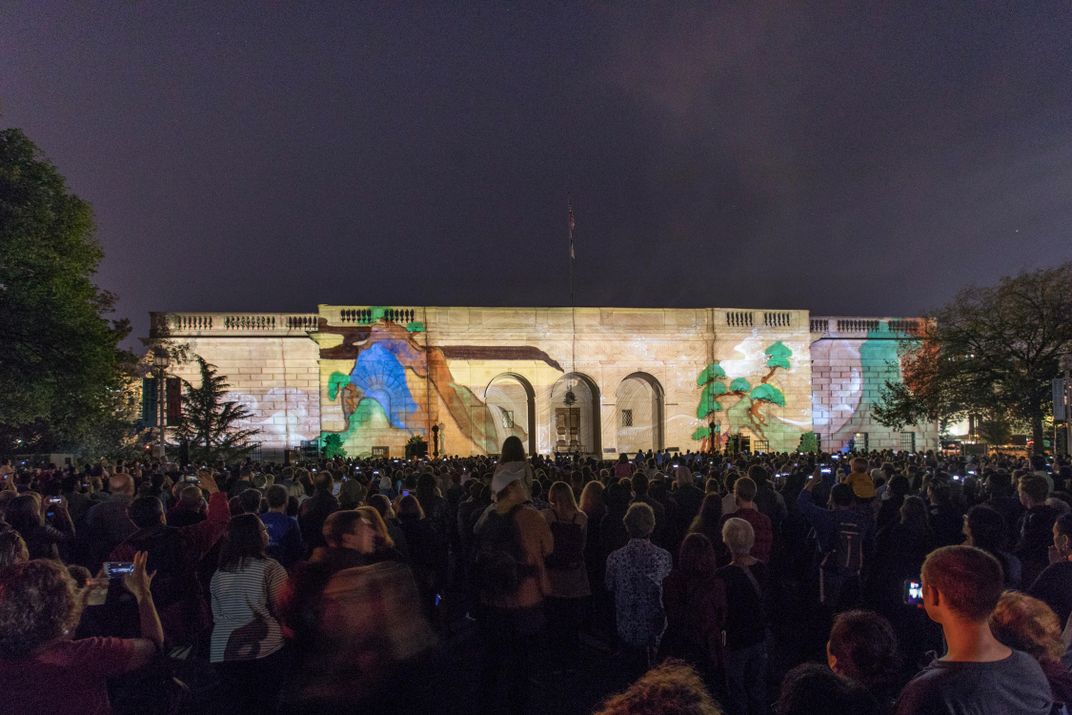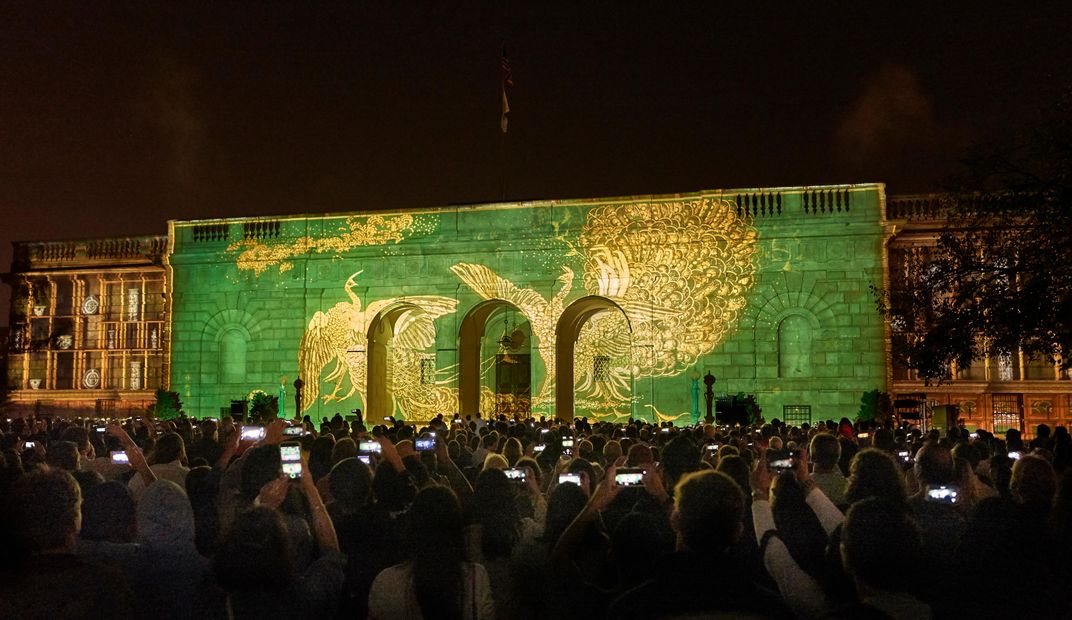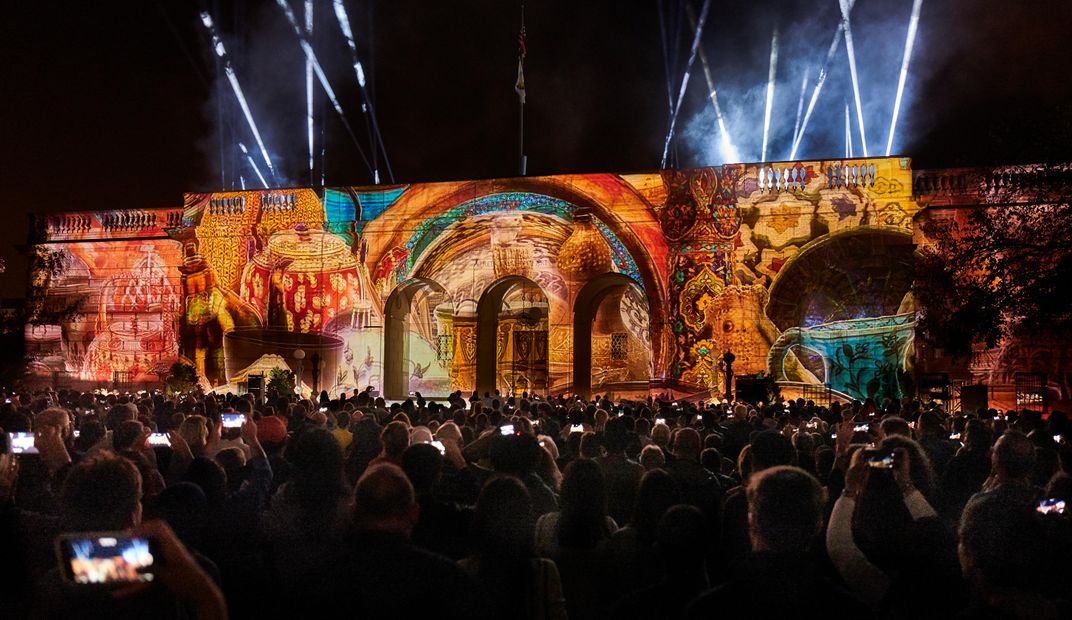Here’s What It Takes to Turn a Museum into a Movie Screen
To mark the reopening of the Freer Gallery, the façade of the newly renovated museum made its cinematic debut
Most evenings, as the sun sets on the bustling National Mall, the tourists scatter, the food trucks drive off, and all goes quiet as the museums close. But every so often after dark, they become lively works of art in their own right. On October 14, the façade of the newly renovated Freer Gallery of Art was alight with a short projection-mapped film, A Perfect Harmony, that highlights the history, culture, and artwork that define the collections.
The installation was part of a weekend-long Smithsonian festival titled “IlluminAsia”—which featured Asian food markets, art and cooking demonstrations and music by the Silk Road Ensemble—to mark the museum’s re-opening. For 22 months, the shuttered building has been undergoing some much needed, largely behind-the-scenes upgrading of its infrastructure and refurbishing of its galleries.
Nestled on the National Mall, near the Smithsonian Castle, the Freer Gallery is home to the country’s acclaimed collection of Asian art, seemingly incongruously housed in an Italian palazzo building. But to Charles Lang Freer (1854-1919), who donated his extensive collection to the United States and designed the museum to showcase it, these disparate elements dovetail flawlessly.
A follower of the Aesthetic movement, “Freer had this conception of beauty that transcended cultures,” explains Thomas Wide, assistant director of special projects at Smithsonian’s Freer Gallery of Art and Arthur M. Sackler Gallery. As collector, designer, founder and financier, Freer was immersed in the creation and stewardship of the museum’s creation. He proposed the museum in 1906 and helped design it, but he didn’t live to see the opening in 1923.
The film’s title, A Perfect Harmony, comes from a letter by artist Dwight William Tryon to Freer. As Lee Glazer, the museum’s associate curator of American art explains, Freer liked to “develop unexpected cross-cultural connections [and] comparisons” by placing diverse objects together. By doing so, Wide says, he was able to find “harmony in this collection of American and Asian art, across culture, across time and place.”
The animation in A Perfect Harmony traces the life of the wealthy railroad industry magnate, who hailed from Detroit, Michigan, and became a patron and friend to James Abbott McNeill Whistler. It was Whistler, an artist whose work was inspired by Japanese and Chinese art, who first sparked Freer’s interest in Asian art.
The film explores the Freer’s extensive and unusual travels across Egypt, Japan and China, and his acquisition of more than 9,000 artworks and antiquities along the way. Highlighting the breadth of the collection, the exterior of the museum was draped with images of the artworks in the Freer and Sackler Galleries, including Whistler’s famed Peacock Room and land- and seascapes by Katsushika Hokusai and Tawaraya Sotatsu, as well as Chinese jades, Southern Indian bronzes, Egyptian glass and Persian lapis lazuli.
The intricate process of projection mapping in A Perfect Harmony involved scanning the building and using a 3D model of it as the basis of the animation. The animators used specialized computer software and multiple video projectors to display the film on an irregular surface—in this case, the Freer’s granite exterior.
Over the years, other museums on the Mall have become canvases for projection-mapping projects. In spring of 2012, artist Doug Aitken broadcast a pop music-based piece SONG 1 onto the curved facade of the Hirshhorn building, and, a year before it officially opened in fall of 2016, the five-story exterior of the National Museum of African American History and Culture became a movie screen for a historical video projection by the critically-acclaimed documentary filmmaker Stanley J. Nelson.
Behind the Freer’s rich visual feat was project director Richard Slaney and about a dozen animators, designers and sound designers from the UK-based studio 59 Productions, best known for its projection mapping projects at the 2012 London Olympics and for the play War Horse.
Slaney and his crew integrated the building so thoroughly in the film that they were able to animate each of its individual bricks and even transform the museum into completely different structures. On the night of the presentation, the audience caught a glimpse of an Isfahani courtyard and a Japanese temple mystically summoned to the National Mall.
In creating the film for the Freer|Sackler, Slaney and his team poured over the extensive archives and artworks to explore “what this collection means today and going forward.” At their heart of the installation, Slaney explains, is highlighting the Galleries as “a space for thinking differently, for being inspired by Asian cultures, for embracing different cultures.”
By donating his collection and constructing a space for Americans to enjoy it, Freer offered “a great democratic act on his part,” Wide says. “And I think the other part of that democratic act was to help people see beauty, to stimulate a way of seeing that Freer found in his own life very therapeutic, powerful, meaningful.”
UPDATE 10/20/1017: This article now includes images of the projection-mapped film, A Perfect Harmony.



